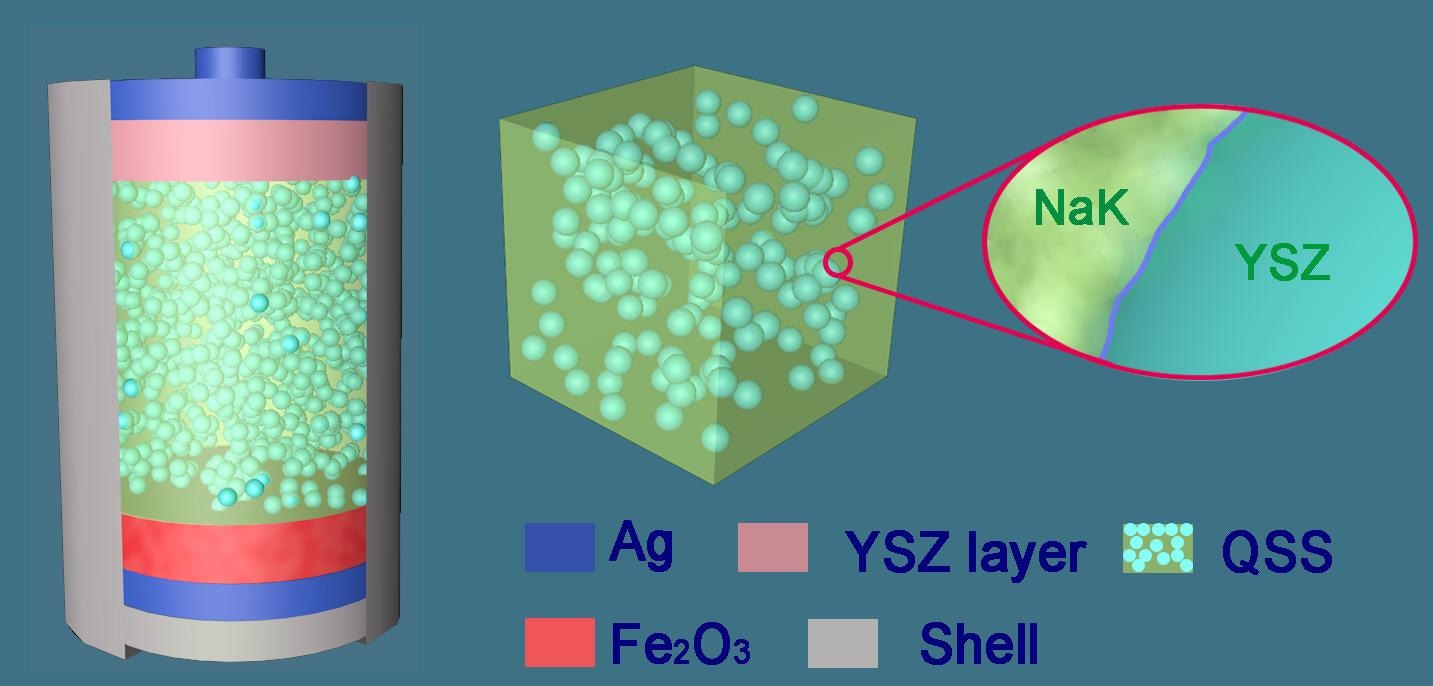Feb 2 2021
Scientists from China and the United Kindom have used salt as the main ingredient to design a new kind of rechargeable battery that could expedite the transformation to a greener electric transport on the roads.
 A quasi-solid-state (QSS) molten salt electrolyte and the structure of QSS molten salt iron air battery. Image Credit: University of Nottingham.
A quasi-solid-state (QSS) molten salt electrolyte and the structure of QSS molten salt iron air battery. Image Credit: University of Nottingham.
Rechargeable lithium-ion batteries, which power several electric vehicles (EV), can lose power and energy over time. These batteries can also overheat while charging or working under specific conditions, which could lead to degradation of battery life and a decrease in miles per charge.
To find solutions to these problems, the University of Nottingham has collaborated with six scientific research institutes in China to create a novel and cost effective energy storage option with the combined performance benefits of a metal-air battery and a solid-oxide fuel cell.
The new battery could considerably extend the range of electric vehicles, while also being eco-friendly, fully recyclable, safe and inexpensive.
A solid-oxide fuel cell transforms oxygen and hydrogen into electricity through a chemical reaction. Although this fuel cell is durable, highly efficient in harnessing energy from a fuel, greener and inexpensive to produce, it is not rechargeable.
At the same time, metal-air batteries are electrochemical cells using a cheap metal like iron and the oxygen in air to produce electricity.
Metal-air batteries release only oxygen into the atmosphere during charging. While not being so durable, these high-energy dense batteries can be recharged and can store and release as much electricity as lithium-ion batteries, yet in a safer and more inexpensive way.
In the early stages of the research, the researchers investigated a high temperature, iron-air battery design that involves using molten salt as a kind of electrolyte—heat activated—for electrical conductivity.
Molten salts are low cost and inflammable, and thus offer a battery excellent energy storage and power capability, as well as long service life. But molten salts also present adverse properties.
In extreme heat, molten salt can be aggressively corrosive, volatile and evaporate or leak, which is challenging to the safety and stability of battery design. There was an urgent need to fine-tune these electrolyte characteristics for better battery performance and to enable its future use in electric transport.
George Chen, Study Lead and Professor, Faculty of Engineering, University of Nottingham
Now, the team has successfully enhanced the technology by converting the molten salt into soft-solid salt with the help of solid oxide nano-powders.
The leader of the collaboration project Professor Jianqiang Wang, from the Shanghai Institute of Applied Physics of the Chinese Academy of Sciences, has estimated that this quasi-solid-state (QSS) electrolyte is appropriate for metal-air batteries operating at 800 °C—almost the same as that of the engine exhaust gas from diesel or petrol engine—as it inhibits the fluidity and evaporation of the molten salts that can take place at such high operating temperatures.
Theoretically, an effective working temperature can be maintained by the currents for charging and discharging of the battery, optimal thermal insulation and some more electric heating if required.
Dr Cheng Peng, a project collaborator also from the Shanghai Institute of Applied Physics describes an exclusive and useful design feature of this experimental study.
The researchers realized the quasi-solidification by using nanotechnology to create a flexibly connected network of solid oxide particles that serve as a structural barrier that locks in the molten salt electrolytes, while still permitting them to safely conduct electricity under extreme heat.
Professor Chen, who leads a molten salt electrolysis laboratory in Nottingham, is confident that the “encouraging results” achieved by the researchers will help develop a more efficient and simpler technique for designing high performance and low cost molten salt metal-air batteries with high safety and stability.
The modified molten salt iron-oxygen battery has great potential applications in new markets, including electric transport and renewable energy which require innovative storage solutions in our homes and at grid-level. The battery is also, in principle, capable of storing solar heat as well as electricity, which is highly-desirable for both domestic and industrial energy needs.
George Chen, Study Lead and Professor, Faculty of Engineering, University of Nottingham
“Molten salts are currently used at large scale in Spain and China to capture and store solar heat which is then converted to electricity—our molten salt metal air battery does the two jobs in one device,” concluded Professor Chen.
Journal Reference:
Zhang, S., et al. (2021) Quasi-solid-state electrolyte for rechargeable high-temperature molten salt iron-air battery. Energy Storage Materials. doi.org/10.1016/j.ensm.2020.11.014.